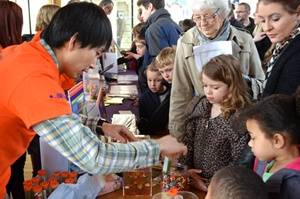IFR Experiment in the Cathedral
29th March 2016
 IFR’s researchers met with hundreds of people of all ages during Norwich Cathedral’s Science Festival.
IFR’s researchers met with hundreds of people of all ages during Norwich Cathedral’s Science Festival.
On Saturday March 12th, thousands of people visited “Experiment in the Cathedral” – a day of family fun and a chance to meet some of the many scientists from different disciplines who work in and around Norfolk.
IFR’s researchers developed a range of new activities based on our research on gut microbes. “Pin the bug on the gut” introduced the concept that our digestive system is home to trillions of different bacteria. It also explored concepts around how these bacteria have adapted to live in different parts of the digestive system. Some “bad” bacteria were included in the activity, introducing ideas about how we try to keep these out to stop them causing disease, and how our bodies provide a suitable habitat for the “good” bacteria that benefit our health.
 How our bodies make a comfortable home for the beneficial bacteria was the subject of another activity. We produce a complex layer of mucus to cover our gut lining, helping bacteria attach and also providing nutrition. “Mucus and gut microbes” used fake mucus slime to engagingly explore how we manipulate the mucus layer’s density to benefit the bacteria, but prevent them getting too close and crossing the gut lining itself.
How our bodies make a comfortable home for the beneficial bacteria was the subject of another activity. We produce a complex layer of mucus to cover our gut lining, helping bacteria attach and also providing nutrition. “Mucus and gut microbes” used fake mucus slime to engagingly explore how we manipulate the mucus layer’s density to benefit the bacteria, but prevent them getting too close and crossing the gut lining itself.
How we help maintain a healthy population of gut bacteria was the topic of another activity, which compared different types of carbohydrate in our diet. In general, we have too much simple sugar in our diet, but not enough complex carbohydrate, or fibre. More fibre is good for our microbiome, as the complex carbohydrates aren’t broken down by our own digestive system, but the bacteria, and this provides a valuable source of nutrition for them. Keeping the bacteria healthy helps them provide maximum benefit to our own health.
 Other activities celebrated IFR’s “Heroes of Food Research” – the volunteer participants who agree to take part in studies to help us understand exactly how different foods affect our health. Visitors to the cathedral were able to sample Beneforté broccoli soups, used in studies to understand how this variety of broccoli might reduce the risk of chronic diseases. Another exhibit showcased a recent study comparing blood orange juice with “normal” orange juice, to assess what effect anthocyanin, the compound responsible for the red colouring, have on risk of cardiovascular disease. It’s not just the content of a food that alters how it affects our health, but also its structure, epitomised by a recent trial on porridge, comparing how processing oats might affect how they are digested in the body.
Other activities celebrated IFR’s “Heroes of Food Research” – the volunteer participants who agree to take part in studies to help us understand exactly how different foods affect our health. Visitors to the cathedral were able to sample Beneforté broccoli soups, used in studies to understand how this variety of broccoli might reduce the risk of chronic diseases. Another exhibit showcased a recent study comparing blood orange juice with “normal” orange juice, to assess what effect anthocyanin, the compound responsible for the red colouring, have on risk of cardiovascular disease. It’s not just the content of a food that alters how it affects our health, but also its structure, epitomised by a recent trial on porridge, comparing how processing oats might affect how they are digested in the body.
We carry out studies with people as this is important to understand how foods work in the real world, but sometimes it’s just not possible to see what is happening deep inside us. But mathematical and computer modelling can help recreate the complexities in a virtual world, and visitors were given a taste of this.
The Science Festival at Norwich Cathedral ran over two weeks and included a range of different events exploring how our world continually changes, how science impacts on our faith and how faith impacts on the world of the scientist. Simon Carding from the Gut Health and Food Safety Programme took part in a panel discussion on food, health and the environment.








